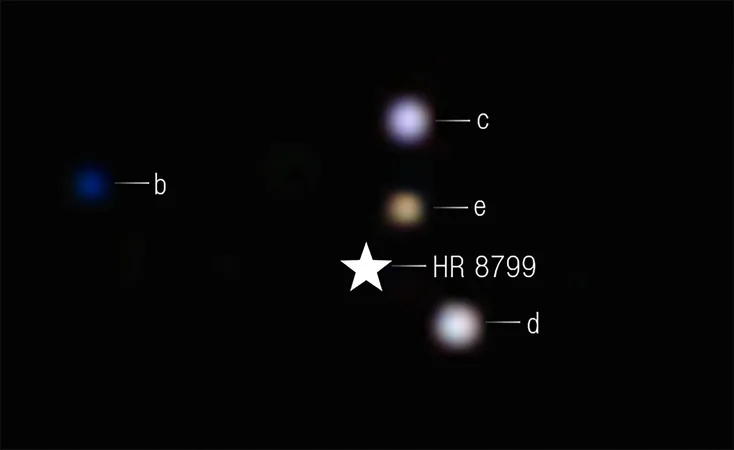
Stunning New Images Reveal Carbon Dioxide in Exoplanets, Thanks to JWST!
2025-03-20
Author: Jia
NASA’s James Webb Space Telescope (JWST) has made an incredible breakthrough by capturing direct images of multiple gas giants in the HR 8799 planetary system, located a remarkable 130 light-years away from Earth. This vibrant and youthful star system, estimated to be only 30 million years old, is an exciting frontier for studying planetary formation processes that could reshape our understanding of how celestial bodies like Jupiter and Saturn came into existence.
In a groundbreaking revelation, analysis of these exoplanets has shown they possess rich atmospheres filled with carbon dioxide. The discovery not only supports the theory of core accretion—the gradual formation of solid cores that attract surrounding gas through gravitational pull—but also raises important questions about the nature and diversity of planetary systems throughout the cosmos.
The Atmospheres of Distant Worlds
The Webb Telescope's advanced spectroscopic capabilities have allowed scientists to infer the chemical makeup of these distant planets. By isolating spectral signatures, researchers found substantial amounts of heavier elements, including carbon, oxygen, and iron, nestled within the atmospheres of HR 8799's gas giants. William Balmer from Johns Hopkins University highlighted, “Detecting these strong carbon dioxide features confirms the presence of heavier elements, pointing towards their core accretion formation theory.”
Understanding Gas Giants
Gas giants can form through two primary methods: one involves the solid-core growth that attracts gas, similar to the known formation of Jupiter and Saturn, while the other consists of a rapid collapse of gas particles into a substantial object within a cooling star’s disk. By studying HR 8799, scientists aim to determine the prevalence of these processes, which will ultimately help distinguish between different planetary systems.
Balmer articulated the broader impact of this research: “Our goal is not just to understand these exoplanets, but to provide context for our own solar system and our place within the universe.”
Innovative Imaging Technology Unveiled
Despite the existence of over 6,000 known exoplanets, direct imaging remains a challenge, as even massive planets shine thousands of times dimmer than their host stars. JWST's Near-Infrared Camera (NIRCam) utilized advanced coronagraph technology to block starlight, thereby illuminating these hidden worlds. This innovative imaging process significantly enhances our understanding of distant atmospheres and their compositions.
Exploring New Frontiers: Giants or Brown Dwarfs?
As researchers delve deeper, they are confronted with another intriguing question—are the observed objects true gas giants or brown dwarfs, which form like stars but are too under-massive to sustain nuclear fusion? Astronomers, including Laurent Pueyo from the Space Telescope Science Institute, are working diligently to clarify this ambiguity, noting that ongoing observations are crucial for resolving these uncertainties.
A Promising Future for Astronomical Discoveries
The James Webb Space Telescope, the pinnacle of modern space observatories, represents a collaborative effort between NASA, the European Space Agency (ESA), and the Canadian Space Agency. It stands poised to continue its mission of unraveling the mysteries of our cosmos, fostering a deeper understanding of gas giants and other exoplanets.
As JWST gazes further into the universe’s depths, it provides invaluable insights not only into the origins of planetary systems but also into our own existence amid the stars. With every discovery, we come closer to answering the age-old question: how unique is our solar system?
Stay tuned as we continue to share exciting updates on unraveling the vast secrets of the universe through the remarkable capabilities of the JWST!

 Brasil (PT)
Brasil (PT)
 Canada (EN)
Canada (EN)
 Chile (ES)
Chile (ES)
 Česko (CS)
Česko (CS)
 대한민국 (KO)
대한민국 (KO)
 España (ES)
España (ES)
 France (FR)
France (FR)
 Hong Kong (EN)
Hong Kong (EN)
 Italia (IT)
Italia (IT)
 日本 (JA)
日本 (JA)
 Magyarország (HU)
Magyarország (HU)
 Norge (NO)
Norge (NO)
 Polska (PL)
Polska (PL)
 Schweiz (DE)
Schweiz (DE)
 Singapore (EN)
Singapore (EN)
 Sverige (SV)
Sverige (SV)
 Suomi (FI)
Suomi (FI)
 Türkiye (TR)
Türkiye (TR)
 الإمارات العربية المتحدة (AR)
الإمارات العربية المتحدة (AR)